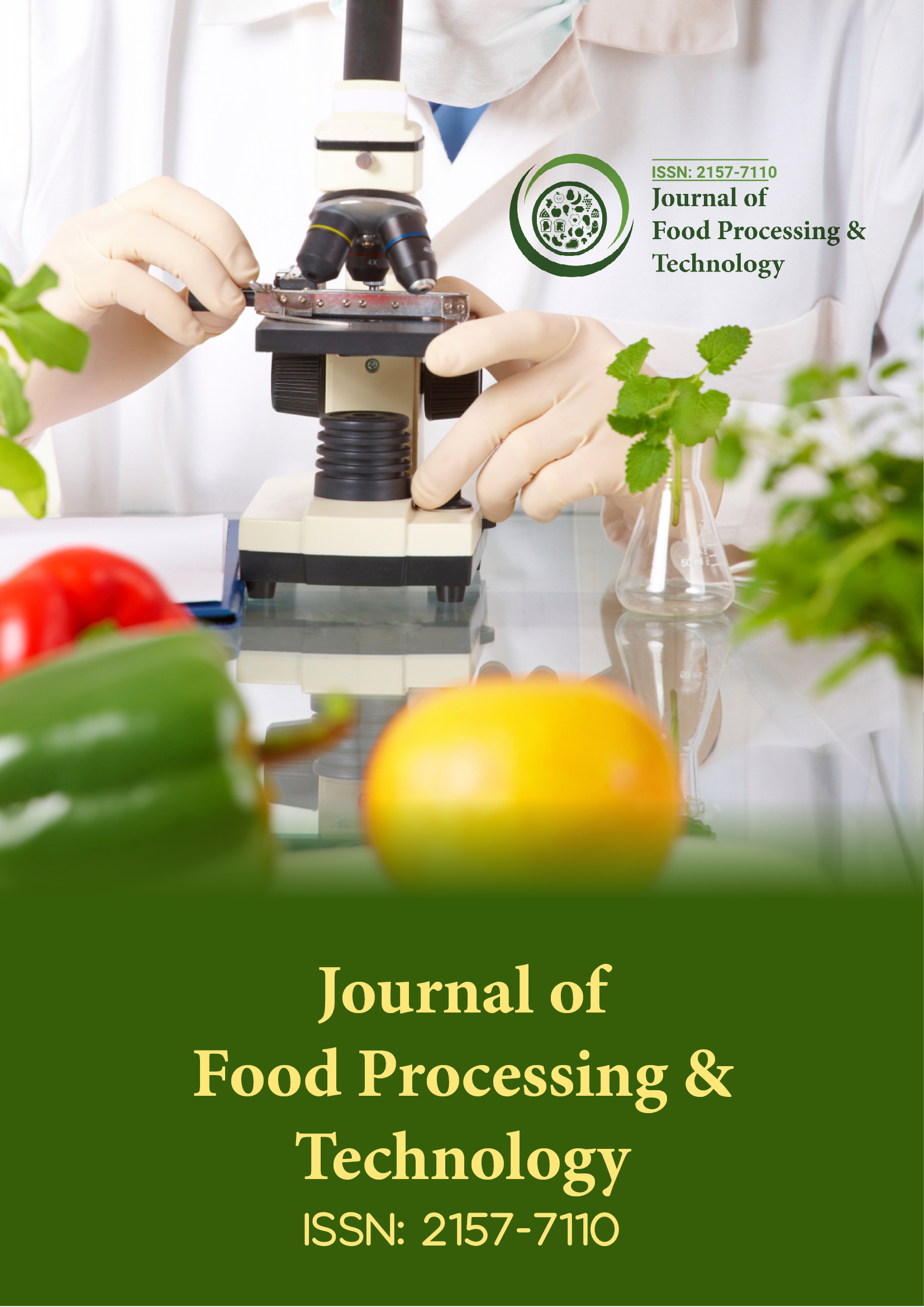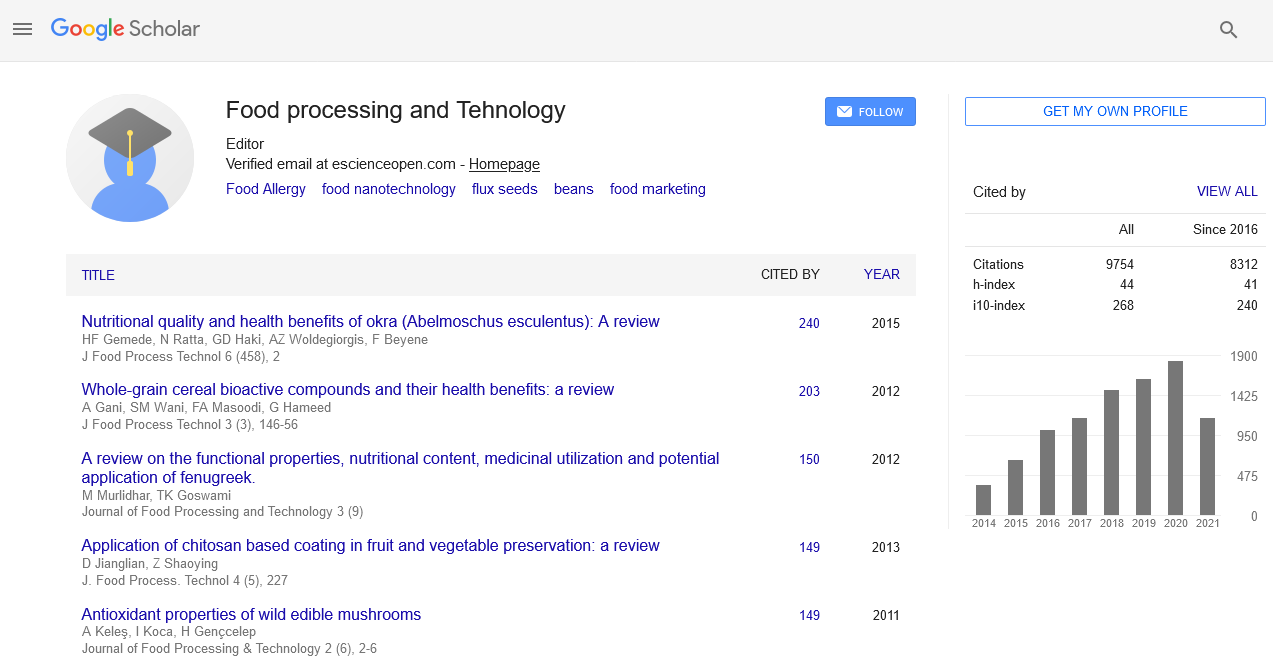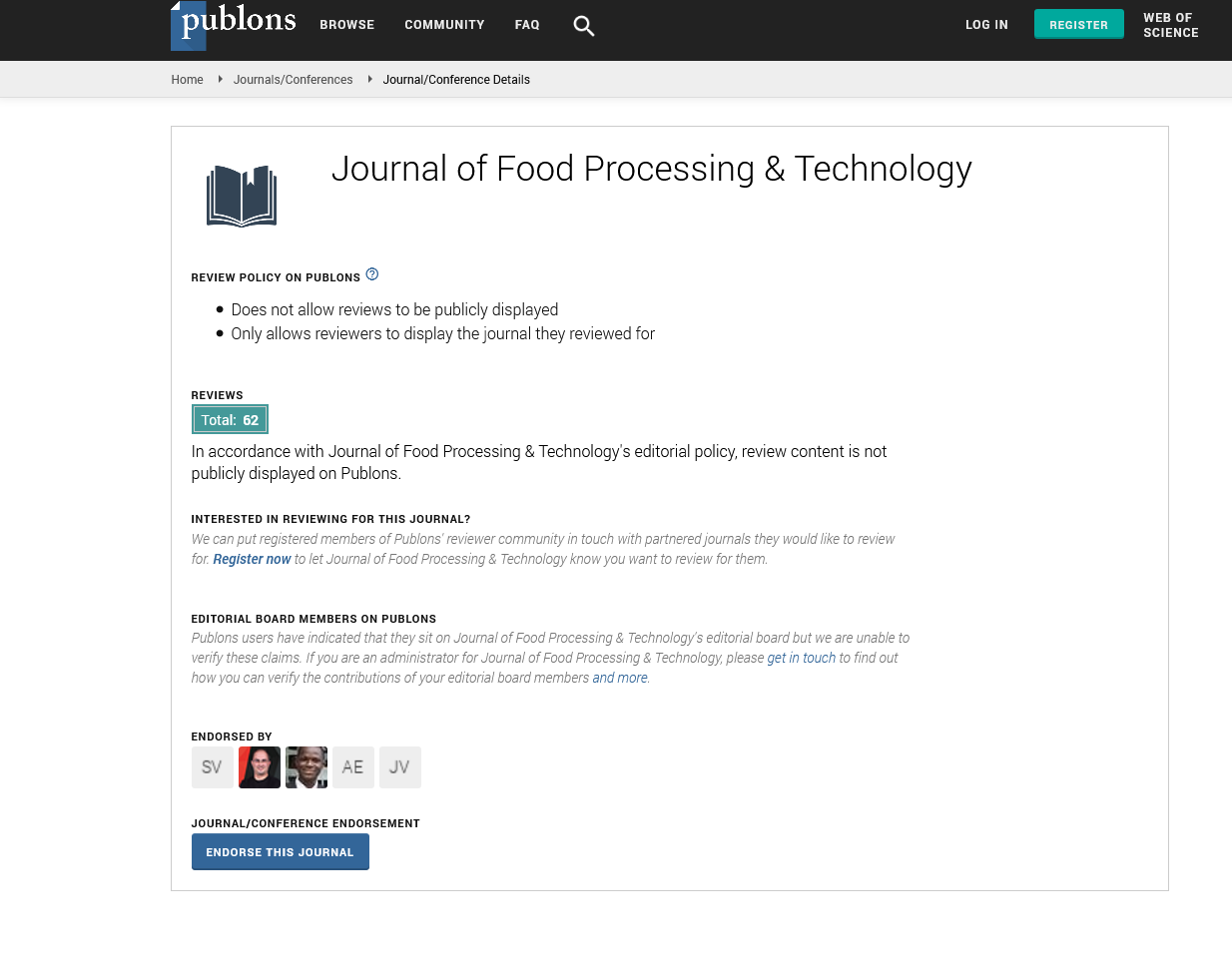Indexed In
- Genamics JournalSeek
- Academic Keys
- JournalTOCs
- China National Knowledge Infrastructure (CNKI)
- Access to Global Online Research in Agriculture (AGORA)
- Centre for Agriculture and Biosciences International (CABI)
- RefSeek
- Directory of Research Journal Indexing (DRJI)
- Hamdard University
- EBSCO A-Z
- OCLC- WorldCat
- Scholarsteer
- SWB online catalog
- Publons
- Euro Pub
- Google Scholar
Useful Links
Share This Page
Journal Flyer

Open Access Journals
- Agri and Aquaculture
- Biochemistry
- Bioinformatics & Systems Biology
- Business & Management
- Chemistry
- Clinical Sciences
- Engineering
- Food & Nutrition
- General Science
- Genetics & Molecular Biology
- Immunology & Microbiology
- Medical Sciences
- Neuroscience & Psychology
- Nursing & Health Care
- Pharmaceutical Sciences
Perspective - (2025) Volume 16, Issue 1
Edible Coatings to Enhance Postharvest Life of Fruits
Mei Lin*Received: 27-Jan-2025, Manuscript No. JFPT-25-29161; Editor assigned: 29-Jan-2025, Pre QC No. JFPT-25-29161; Reviewed: 12-Feb-2025, QC No. JFPT-25-29161; Revised: 18-Feb-2025, Manuscript No. JFPT-25-29161; Published: 26-Feb-2025, DOI: 10.35248/2157-7110.25.16.1138
Description
Edible coatings have emerged as a promising postharvest technology to extend the shelf life and preserve the quality of fresh fruits. As global demand rises for minimally processed, safe and environmentally friendly preservation methods, edible coatings offer an effective solution that aligns with consumer preferences for natural and sustainable food packaging alternatives. These coatings form a thin, biodegradable layer on the surface of fruits, acting as a semi permeable barrier to moisture, gases and solutes. By modifying the internal atmosphere of the fruit and reducing respiration rates, they help in slowing down ripening, senescence and microbial spoilage, thereby extending postharvest life without the need for synthetic additives or extensive refrigeration.
The application of edible coatings is rooted in the use of natural polymers such as polysaccharides, proteins and lipids, each offering distinct functional properties. Polysaccharide based coatings, derived from materials like chitosan, cellulose derivatives, alginate, starch and pectin, are widely used due to their excellent film forming ability and gas barrier properties. Chitosan, for example, obtained from the deacetylation of chitin, exhibits strong antimicrobial activity in addition to forming a transparent and flexible film. It has been extensively studied for coating fruits such as strawberries, bananas and mangoes to reduce microbial spoilage and delay ripening. Alginate, extracted from brown seaweed, forms a gel like matrix in the presence of calcium ions and is effective in reducing moisture loss and maintaining firmness in coated fruits.
Protein based coatings, made from whey protein, casein, soy protein, or gelatin, provide good oxygen barrier properties and can be tailored with functional additives to improve fruit preservation. These coatings are particularly useful in reducing oxidative processes and preserving color and flavor. Lipid based coatings, such as those made from waxes, fatty acids, or essential oils, offer excellent moisture barrier properties but may be less effective in controlling gas exchange. Hence, multilayer or composite coatings that combine the benefits of different materials are increasingly being explored to achieve optimal protection for fruits during storage and transportation.
One of the critical mechanisms by which edible coatings enhance postharvest life is through the modification of internal gas composition. Fruits continue to respire after harvest, consuming oxygen and releasing carbon dioxide, which leads to ethylene production, a natural plant hormone that accelerates ripening. By forming a barrier to gas exchange, edible coatings reduce the oxygen availability and increase carbon dioxide levels around the fruit, thereby suppressing ethylene biosynthesis and slowing down metabolic activity. This results in a delayed ripening process, extended shelf life and preservation of texture and nutritional content. In addition, reduced respiration helps in minimizing the loss of sugars and organic acids, thereby maintaining flavor and taste.
Another major benefit of edible coatings is their ability to reduce water loss, which is a significant factor contributing to postharvest deterioration. Moisture loss leads to fruit shrinkage, weight loss, wilting and loss of crispness, making fruits less appealing to consumers. Lipid containing coatings are particularly effective in forming hydrophobic barriers that prevent water vapor transmission and reduce transpiration. This is especially important for fruits with high surface area to volume ratios or thin skins, such as berries and grapes, which are prone to rapid desiccation.
Edible coatings also offer a platform for incorporating active ingredients such as antimicrobial agents, antioxidants and nutritional enhancers. The inclusion of natural antimicrobials like essential oils (e.g., thymol, eugenol and cinnamaldehyde), plant extracts, or bacteriocins in the coating matrix can inhibit the growth of spoilage microorganisms and pathogens on the fruit surface. This approach has been shown to significantly reduce the incidence of decay causing fungi such as Botrytis cinerea and Penicillium spp., thereby extending the microbial shelf life of coated fruits. Antioxidants such as ascorbic acid or tocopherols can also be incorporated to reduce oxidative browning and preserve the visual and nutritional quality of fruits like apples, pears and avocados.
Furthermore, the application of edible coatings is a relatively simple and scalable process that can be integrated into existing postharvest handling systems. Coatings can be applied using methods such as dipping, spraying, or brushing, depending on the type of fruit and the desired coating thickness. The process is cost effective, non-invasive and does not require complex equipment or high energy input, making it suitable for use in both large scale commercial operations and smallholder farming systems.
The effectiveness of edible coatings depends on various factors, including the type of fruit, the composition and thickness of the coating, the storage temperature and humidity and the presence of added functional agents. Each fruit has unique physiological characteristics and postharvest behavior, which must be considered when selecting the appropriate coating formulation. For example, climacteric fruits such as bananas, mangoes and papayas benefit from coatings that reduce ethylene sensitivity, while non-climacteric fruits like grapes and citrus may require more emphasis on moisture retention and antimicrobial protection.
Citation: Lin M (2025). Edible Coatings to Enhance Postharvest Life of Fruits. J Food Process Technol.16: 1138.
Copyright: © 2025 Lin M. This is an open access article distributed under the terms of the Creative Commons Attribution License, which permits unrestricted use, distribution and reproduction in any medium, provided the original author and source are credited.


